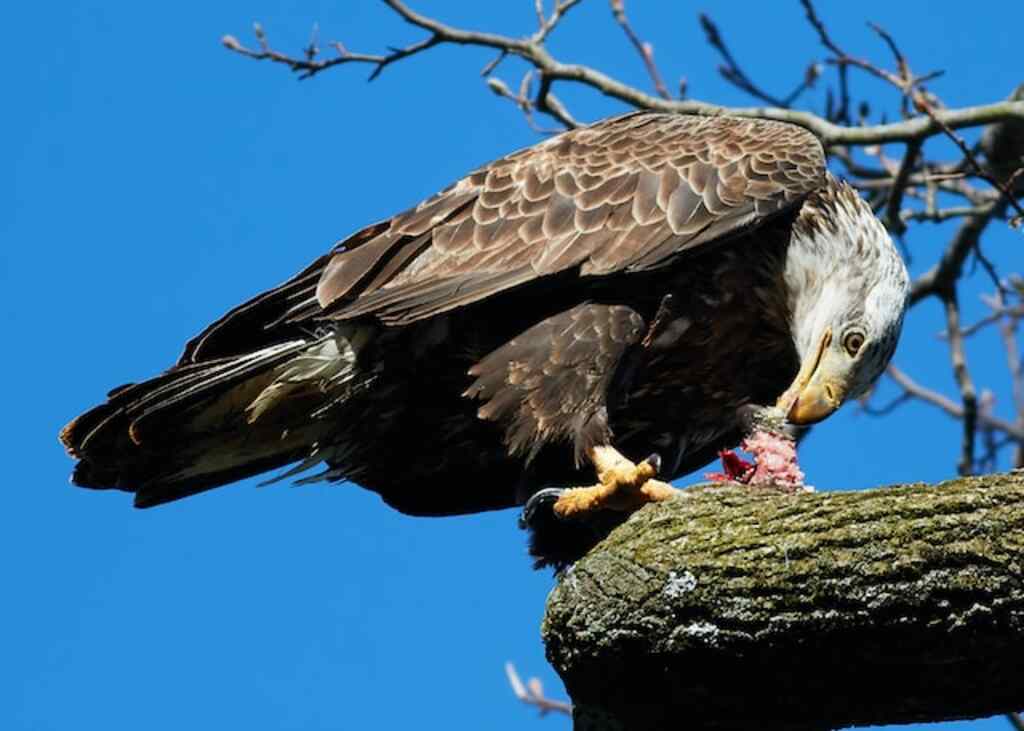Do Eagles Eat Carrion? Prepare to uncover the truth about these majestic birds’ dining habits. While live prey makes up a significant portion of their diet, recent studies reveal that carrion consumption is not uncommon.
Join us as we explore the fascinating reasons behind their occasional feast on the deceased, discover the ecological implications, and debunk prevailing misconceptions.
Get ready for an enlightening journey into the captivating world of eagle dining!
Table of Contents
- 1 Key Takeaways
- 2 The Diet of Eagles
- 3 Misconceptions about Eagle Feeding Habits
- 4 Do Eagles Eat Carrion
- 5 Carrion Consumption by Eagles
- 6 Benefits of Carrion Consumption
- 7 Factors Influencing Eagle’s Decision to Consume Carrion
- 8 Adaptations for Carrion Consumption
- 9 Carrion Consumption as a Survival Strategy
- 10 Implications for Conservation and Wildlife Management
- 11 Research and Studies on Eagle Feeding Behavior
- 12 Frequently Asked Questions
- 12.1 How often do eagles consume carrion?
- 12.2 Do eagles only eat carrion when they cannot find live prey?
- 12.3 Are there any health risks associated with eagles consuming carrion?
- 12.4 Can eagles differentiate between fresh carrion and decomposed carcasses?
- 12.5 Are there any negative impacts of eagles consuming carrion on the ecosystem?
- 13 Conclusion
- 14 Author
Key Takeaways
- Eagles primarily consume live prey such as fish, small mammals, and birds, with carrion making up a smaller portion of their diet.
- Factors such as prey scarcity, age and health, competition, and availability of alternative food sources influence an eagle’s decision to consume carrion.
- Carrion consumption provides important nutrients and energy, especially during times of prey scarcity, and helps maintain ecosystem balance by reducing disease spread and aiding in decomposition and nutrient recycling.
- Eagles have adaptations for carrion consumption, including beak shape and strength, and a digestive system that aids in breakdown and digestion of carrion tissues.

The Diet of Eagles
The diet of eagles encompasses a variety of food sources, including carrion.
Common misconceptions about eagle feeding habits often overlook their ability to consume carrion, focusing instead on their prowess as hunters.
However, carrion provides important nutritional benefits for eagles, particularly during times when prey is scarce.
Understanding the diverse range of food sources in an eagle’s diet is crucial to dispelling misconceptions about their feeding habits.
Misconceptions about Eagle Feeding Habits
Common myths surrounding eagle feeding habits will be debunked in this discussion, shedding light on the true nature of their dietary preferences.
Additionally, factors influencing eagle feeding preferences will be explored, providing insight into the various elements that shape their diet.
This analysis will adopt an academic style of writing, maintaining objectivity and impersonality throughout the discussion.
Common Myths Debunked
Misconceptions about eagle feeding habits are often propagated, but it is necessary to clarify that carrion does not form a significant part of their diet.
Myth debunking reveals that eagles primarily prey on live animals, such as fish, small mammals, and birds. They have strong hunting skills and prefer fresh prey.
Understanding these feeding preferences is crucial to comprehending the factors influencing their diet choices.
Factors Influencing Feeding Preferences
Factors that influence the dietary preferences of eagles include the availability of fresh prey, their strong hunting skills, and their inclination towards live animals such as fish, small mammals, and birds.
Eagles have a diverse feeding behavior, adapting to different environments and food sources.
They are known for their scavenging adaptation, allowing them to consume carrion when other prey is scarce. In the next section, we will explore the consumption of carrion by eagles and its implications.

Do Eagles Eat Carrion
Yes, eagles do eat carrion. While their diet primarily consists of live prey, eagles also scavenge on carrion, which serves as a valuable food source.
Consuming carrion provides essential nutrients and supports their survival. Carrion plays a role in the ecological balance and decomposition process.
Carrion Consumption by Eagles
Eagles are known to consume carrion as part of their natural feeding behavior. This behavior is influenced by several factors, including the availability of carrion as a food source and the eagles’ scavenging behavior.
Carrion provides eagles with an important source of nutrients and energy, especially during times when prey is scarce. Additionally, consuming carrion can help maintain the balance of ecosystems by reducing the spread of disease.
Transitioning into the subsequent section, understanding the benefits of carrion consumption is crucial in comprehending eagles’ feeding preferences.
Benefits of Carrion Consumption
Carrion consumption by eagles offers several benefits, including the nutritional value of carrion and their ecological role in decomposition.
Carrion provides eagles with a source of nutrients, such as proteins and fats, that are essential for their survival and energy needs.
Additionally, by consuming carrion, eagles play a crucial role in the ecosystem by aiding in the decomposition process and recycling nutrients back into the environment.
Nutritional Value of Carrion
The nutritional value of carrion is often overlooked, despite its potential to provide vital nutrients for certain scavenging species.
Scavengers play a crucial ecological role in decomposition by feeding on dead animals. Carrion is rich in proteins, fats, and minerals, making it a valuable food source.
| Nutrient | Benefit |
|---|---|
| Proteins | Essential for growth and repair of body tissues |
| Fats | Provide energy and support hormone production |
| Minerals | Aid in various bodily functions and enzyme activity |
Carrion, despite its association with decay, offers a surprisingly rich nutritional profile. Scavengers, including eagles, recognize the value of carrion as a source of vital nutrients.
By feeding on carrion, these species contribute to the ecosystem by participating in the natural process of decomposition.
Ecological Role in Decomposition
Carrion plays a crucial ecological role in decomposition, contributing to nutrient cycling and the overall health of ecosystems.
This process also attracts scavengers like eagles, which help in the breakdown of carrion and prevent the spread of disease.
Understanding the ecological impact of carrion consumption is vital to comprehending the factors influencing an eagle’s decision to consume carrion.

Factors Influencing Eagle’s Decision to Consume Carrion
Factors such as the availability of alternative food sources, the age and health of the eagle, and the level of competition for carrion within its habitat influence the decision of an eagle to consume carrion.
1) The availability of alternative food sources can reduce the need for eagles to scavenge carrion.
2) Older and healthier eagles may be more likely to consume carrion due to reduced hunting abilities.
3) Higher competition for carrion can force eagles to scavenge more frequently.
4) The scavenging behavior of eagles can have significant impacts on ecosystem dynamics.
Transitioning into the subsequent section about ‘adaptations for carrion consumption’, eagles have also developed physical and behavioral traits that allow them to efficiently consume carrion.
Adaptations for Carrion Consumption
This discussion will focus on the adaptations that enable eagles to consume carrion, specifically their beak shape and strength, as well as their digestive system modifications.
The beak of an eagle is specially adapted to tear and rip apart carcasses, with a sharp and hooked tip that allows them to efficiently extract meat.
Additionally, their beak is strong enough to handle the tough and sinewy tissues found in carrion.
In terms of their digestive system, eagles have modifications that aid in the breakdown and digestion of carrion, such as a highly acidic stomach and a relatively short digestive tract.
Beak Shape and Strength
Beak shape and strength are crucial in determining the feeding habits and dietary preferences of eagles.
The adage ‘form follows function’ suggests that organisms evolve specific anatomical features that are adapted to their feeding behaviors.
For example, eagles with hooked beaks are well-suited for tearing flesh from carrion, while those with sharp, pointed beaks are more adept at catching and consuming live prey.
These beak adaptations are closely linked to their feeding preferences and play a significant role in their survival.
Moving on to digestive system modifications…
Digestive System Modifications
One crucial aspect of the eagle’s biology that directly affects its feeding habits and dietary preferences is the modification of its digestive system.
These adaptations enable the eagle to efficiently process carrion, which is an important food source for many species of eagles.
The digestive system of an eagle has evolved to handle the decomposition process of carrion, allowing them to extract nutrients from decaying flesh.
This ability to digest carrion plays a crucial role in the eagle’s survival strategy.
Carrion Consumption as a Survival Strategy
Carrion consumption, a common behavior among eagles, is a survival strategy that allows these majestic birds to take advantage of available resources and ensure their own sustenance.
By engaging in scavenging behavior, eagles can obtain vital nutrients from carcasses that would otherwise go to waste.
This adaptive behavior not only contributes to the eagle’s survival but also has implications for conservation and wildlife management, as it highlights the importance of maintaining healthy carrion sources in their habitats.

Implications for Conservation and Wildlife Management
The conservation and wildlife management implications of eagles’ carrion consumption behavior are significant, as it highlights the need for maintaining healthy sources of carcasses in their habitats to ensure the survival and well-being of these majestic birds.
Conservation efforts should focus on protecting and enhancing carrion availability, as it plays a crucial role in the diet and reproductive success of eagles.
Wildlife management strategies should consider the importance of carrion as a valuable resource for eagle populations.
In order to further understand eagle feeding behavior, research and studies have been conducted.
Research and Studies on Eagle Feeding Behavior
This discussion on research and studies on eagle feeding behavior will focus on two key points: field observations and surveys, and tracking and monitoring techniques.
Field observations and surveys involve direct observation of eagles in their natural habitat, noting their feeding behaviors and preferences.
Tracking and monitoring techniques, on the other hand, involve the use of technology such as GPS transmitters and satellite tracking to gather data on eagle movements and feeding patterns.
These methods provide valuable insights into the feeding behavior of eagles, which can inform conservation and wildlife management efforts.
Field Observations and Surveys
Field observations and surveys have revealed that eagles, majestic predators of the sky, demonstrate a keen appetite for carrion.
These findings have been obtained through various tracking and monitoring techniques, including GPS tracking, radio telemetry, and camera trap surveys.
Such research efforts have provided valuable insights into the feeding behavior of eagles and their preference for carrion as a food source.
Understanding these patterns can inform conservation efforts and help protect these magnificent birds. Next, we will delve into the tracking and monitoring techniques used to study eagle feeding behavior.
Tracking and Monitoring Techniques
Moving on from field observations and surveys, the current subtopic focuses on tracking and monitoring techniques used to study the eating habits of eagles.
These techniques allow researchers to gather valuable data on the eagle’s feeding behavior, specifically their inclination towards carrion.
By utilizing various tracking techniques and monitoring methods, such as GPS tracking and remote camera systems, researchers can gain insights into the dietary preferences and foraging patterns of eagles in different habitats.

Frequently Asked Questions
How often do eagles consume carrion?
Eagles consume carrion as part of their diet and exhibit scavenger behavior. The frequency with which eagles consume carrion varies depending on factors such as food availability and competition with other scavengers.
Do eagles only eat carrion when they cannot find live prey?
Eagles do not solely rely on carrion when live prey is scarce. While carrion consumption habits vary among species, eagles consume carrion as a regular part of their diet due to its nutritional value.
Are there any health risks associated with eagles consuming carrion?
There are potential health risks associated with eagles consuming carrion, as it may contain harmful bacteria or toxins. However, carrion can also provide nutritional value to eagles, especially when live prey is scarce.
Can eagles differentiate between fresh carrion and decomposed carcasses?
Eagles possess remarkable olfactory abilities, enabling them to distinguish between fresh carrion and decomposed carcasses. This adeptness in eagle scavenging allows them to selectively consume only the freshest and most nutritious food sources.
Are there any negative impacts of eagles consuming carrion on the ecosystem?
The consumption of carrion by eagles can have positive effects on the ecosystem by contributing to the ecological balance. They help to clean up carcasses and prevent the spread of diseases, thus maintaining a healthy environment.

Conclusion
In conclusion, the diet of eagles is a fascinating topic that has been widely studied and researched. Contrary to common misconceptions, eagles do consume carrion as part of their feeding habits.
This behavior is not only beneficial for eagles in terms of survival and energy conservation, but also plays a crucial role in maintaining the balance of ecosystems.
The ability of eagles to adapt and make use of carrion as a food source showcases their remarkable resilience and resourcefulness.
Just like the eagle soaring high in the sky, these majestic birds have a unique ability to turn what may seem like a mere carcass into a valuable resource, embodying the importance of making the most out of every opportunity in life.


